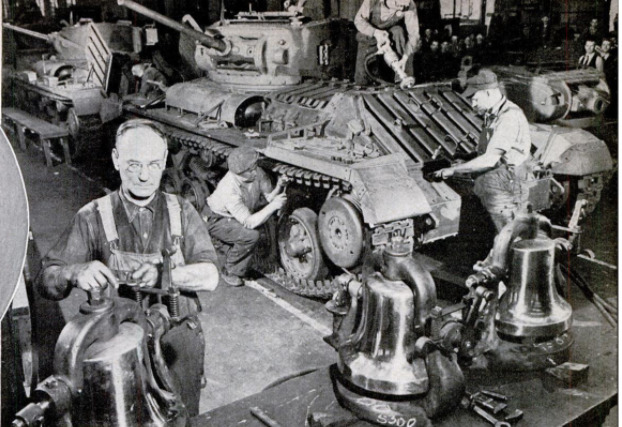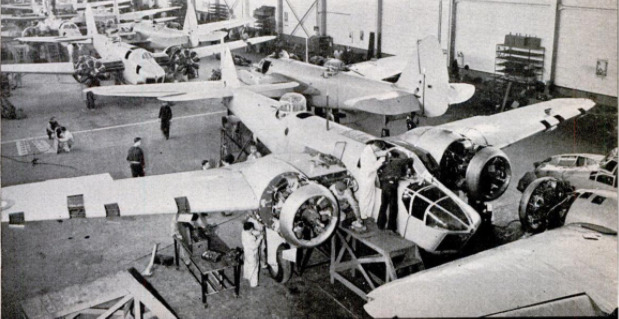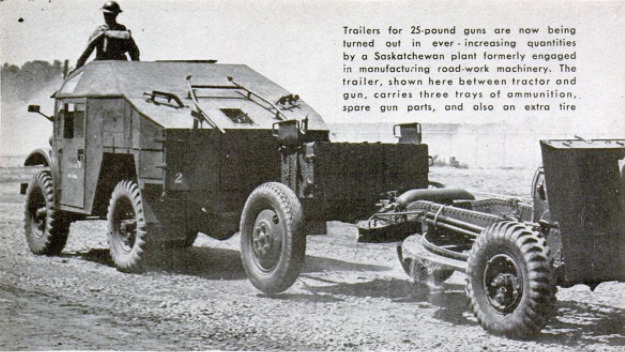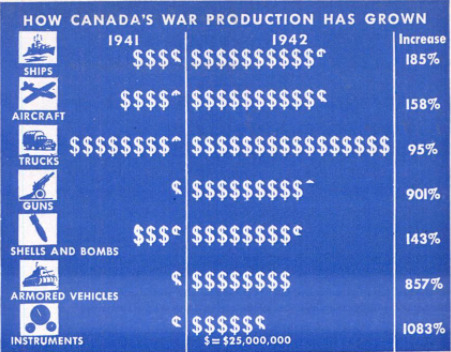-
Title (Dublin Core)
-
Canada goes industrial
-
Article Title and/or Image Caption (Dublin Core)
-
Title: War turns an agricultural country into an arsenal as Canada goes industrial
-
extracted text (Extract Text)
-
CANADA, for three centuries largely
. dependent upon its fields, forests, and
streams for livelihood, has industrialized
itself in the last three years. The war
emergency made it necessary, but Canada
will emerge from the war industrially
minded and industrially equipped.
Almost 1,000,000 of Canada’s population
of 11,500,000 are employed in essential war
industries and 650,000 more are in Canada’s
armed forces. Canada, almost an indus-
trial void in September, 1939, has since then
absorbed war orders aggregating more than
$6,000,000,000, and will spend $3,500,000,000
this year on the war, a sum about equiva-
lent to the entire national income of the
last peace year.
Almost every industrial plant in the
country has been put into war production
and dozens of new plants, put up on an
acreage basis, have sprung up. Prior to
1939 Canada imported all the materials
necessary for her small armed forces. The
fateful year 1939 found it not only short
of factories, but short of machines to build
the tools with which to turn out war sup-
plies. There was a shortage also of mechan-
ical experts.
There were no steel mills producing ar-
mor plate. Tanks which the United States
had built for the first World War had to be
imported for the early training of the
Canadian tank crews. The Canadian Navy
consisted of six destroyers and six mine
sweepers. Tool-making machines were im-
ported. Mechanical experts were borrowed.
Steel mills were equipped to turn out armor
plate. Not only the automotive industry,
but all industry possible was converted to
war use. A laundry, converted in peacetime
to an elevator factory, underwent its second
major operation and now is turning out
great quantities of two-inch smoke-bomb
throwers.
Canada started the war with the idea of
becoming self-sufficient. She has just about
realized her ambition, though peak produc-
tion will not come for some months yet.
The Canadian Navy has more than 500
vessels and they are Canadian-equipped
from steering gear to range finder. The
Canadian airplane industry, which turned
out about 40 craft a year in peacetime,
sends out 400 planes a month.
Except for battleships and the largest
guns, Canada’s war industries not only sup-
ply her war needs, but also turn out a large
surplus for her allies. Thirty percent of
Canada’s war output suffices for her own
armed forces, The rest goes to Russia, to
Great Britain, to the United States. Among
the United Nations, only the United States
and Great Britain surpass Canada in war
production.
From coast to coast, Canadian farmlands
have sprouted factories—shell-filling plants,
chemical plants, war shops of all Kinds.
C. D. Howe, Canadian Munitions and Sup-
ply Minister, said recently that more than
100,000,000 had been spent on construct
ing and equipping chemical plants alone.
An elevator manufacturer has converted
his plant to the manufacture of the Bofors
antiaircraft gun, the bell-mouthed fast-
firer which stands guard in the United
States as well as in Canada and travels
far afield to shoot down its prey. Canada
was able to export these guns, capable of
firing 140 shots a minute, to the United
States before this country was equipped to
turn them out.
A soup-canning plant is making ammu-
nition. A marine engine factory turns out
not only ships’ boilers but also the Boys
antitank guns which can send a .55 caliber,
armor-piercing projectile into the most sen-
sitive and best protected parts of a tank.
Browning aircraft machine guns, auto-
matic rifles, and other weapons also are
coming from the boiler factory.
The automobile factories of Canada, sub-
sidiaries of American companies, are mak-
ing 100 different types of mechanized fight- |
ing vehicles, including mobile machine
shops. Locomotive shops produce tanks at |
the rate of three a day. A shoe manufac-
turer is making naval guns.
Gunsmithing is not a science that is mas-
tered in a short time. The skill and accuracy |
it demands is acquired only after years of
patient practice. Canadian gunsmiths were |
few when Canada went to war. Only once
before—during the first World War—had
Canadian industry been called upon to make
guns, and then it made only infantry rifles.
With few experts to call on, and only blue-
prints and working models to start with, |
Canada set out to make guns in 1939. There
were also the handicaps of a lack of machine
tools, and a lack of raw materials in the
form of steel and castings. Slowly these |
were overcome. Plants were converted,
machine tools were obtained by painstaking
hunting throughout Canada and the United |
States, men and women were recruited for |
the new industry and patiently trained to
do the work.
In last October alone, Canada’s produc-
tion of small arms was almost double its
entire production in 1941. Twelve types of |
small arms, 12 types of guns, and 16 types
of gun carriages were coming out of Cana- |
dian shops. Besides the Bofors guns, the
Browning aircraft machine guns, and the
Boys antitank rifles, 25-pounder field guns
of the most modern type were being pro-
duced by Sorel Industries, Ltd., at the rate
of 50 a month at $25,000 each and the pow-
erful 3.7 antiaircraft guns, which have sev-
eral thousand parts and weigh as much as
a city bus, were coming off the assembly
line at the rate set.
Canadian manufacturers also Were turn-
ing out the four-inch naval gun, the 12-
pounder naval gun, the two-pounder naval
gun, the .50 caliber Vickers naval machine
gun, the two-inch and three-inch trench
mortars, tank bomb throwers, naval depth-
charge throwers, Lee-Enfield rifles, Sten
submachine carbines, and Bren automatic
machine guns.
In machine tools, Canada did another
about-face. In 1939 she needed them desper-
ately. Since 1042 she has been exporting
them to Great Britain and the United States.
Nine types of planes are in production
in Canada, including the Curtiss Hell-Diver,
1,000 of which are being built for the United
States Navy. Another is the British Mos-
quito fighter-bomber, a speedy plane which
was on the “secret list” until recently. Ca-
nadian plants also are turning out the four-
engined Lancaster, a heavy bomber whose
block-busters have destroyed both German
and Italian industrial plants. Hurricanes,
Catalina PBY flying boats, and the Boling-
broke and Anson twin-engined bombers also
are in production in Canada, as well as
trainer planes. Propellers of both metal
and wood are turned out in such numbers
that the United States has been import-
ing them. The Canadian aircraft industry,
which employed about 1,000 persons before
the war, now keeps more than 55,000 men
and women busy. To help the aircraft pro-
gram, Canada has, since the start of the
war, built the largest aluminum plant in
the world to help supply both her own war.
needs and those of the United Nations. The
current capacity of this enormous plant is
already greater than the world's total out-
put of aluminum during the year 1939.
Canada had never made any optical glass
before she entered the war. Imports from
Great Britain, Germany, and the United
States had been relied upon to meet her
needs. A large part of these imports were
cut off just at the moment that Canada
was going to need the glass for range
finders, gunsights, periscopes, and other
instruments. The government-owned Re-
search Enterprises, Ltd, was set up in
Toronto to meet the emergency and within
eight months of the start of the project the
first optical glass was produced.
In a relatively short time the plant not
only was meeting Canada’s needs, but also
was sending its instruments to Canada’s
allies. Its field soon was widened and it
is now manufacturing scientific equipment
of various sorts, including communications
instruments and articles which still are on
the “secret list,” such as radio locators.
The plant turns out optical instruments of
all kinds; navigating instruments for
planes, ships, and fighting vehicles; and
fire-control instruments for the navy.
British shipyards used to supply what
ships were needed for Canada’s ocean and
Great Lakes commerce, and Canada’s ship-
building efforts were confined largely
river, harbor, and fishing craft. Canada
now has 21 major shipyards and 58 smaller
ones. Canada is building 300 cargo ships
of 10,000 tons and a number of 4,700-ton
cargo vessels, utilizing the prefabrication
method. Canada also is turning out de-
stroyers, corvetes, mine sweepers, subma-
rine chasers, and patrol boats of various
types. At least one of the corvettes was
built for the United States. In the latter
part of 1942, Canada’s ship-building pro-
gram, according to Humphrey Mitchell,
Canadian Labor Minister, surpassed that of
Great Britain.
Canadian tanks, both 18-tonners and 30-
tonners, have been fighting on the Russian
front for months and have received high
praise from the Russians. Both Canada
and Great Britain depend upon the prod-
uct of new mercury mines which have
been discovered and developed in Canada
since 1939. A mew magnesium production
method, developed in Canada’s national
Research Council by Dr. L. Pidgeon, is in
use in the United States, and new iron-ore
deposits in the Dominion are furnishing
their quota of the North American output.
While in the throes of this mushroom in-
dustrial development, Canada has kept her
agricultural production at a record height
and has been able not only to feed herself,
but to export to Great Britain, Russia, and
other countries. It is her intention to have
agriculture and industry march abreast in
peace as in war.
-
Contributor (Dublin Core)
-
James Montagnes (Article Writer)
-
Language (Dublin Core)
-
eng
-
Date Issued (Dublin Core)
-
1943-04
-
pages (Bibliographic Ontology)
-
78-81
-
Rights (Dublin Core)
-
Public Domain (Google Digitized)
-
Archived by (Dublin Core)
-
Matteo Ridolfi
-
Marco Bortolami (editor)
-
Spatial Coverage (Dublin Core)
-
Canada
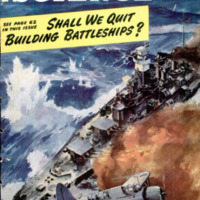 Popular Science Monthly, v. 142, n.4, 1943
Popular Science Monthly, v. 142, n.4, 1943

